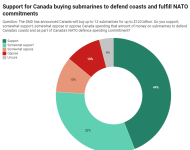- Reaction score
- 8,916
- Points
- 1,160
That would probably require about 16 to 18 SSKs . It would be amusing to watch the Treasury have a collective stroke. As well as the Surface Warfare community.
Why the extra subs?
I am just proposing the patrol routes, not the frequency or duration.
I am assuming that only half of the fleet will actually be at sea or at notice to move.
3 subs dockside refit and 3 subs in long term refit or whatever it is called when they are gutted.




